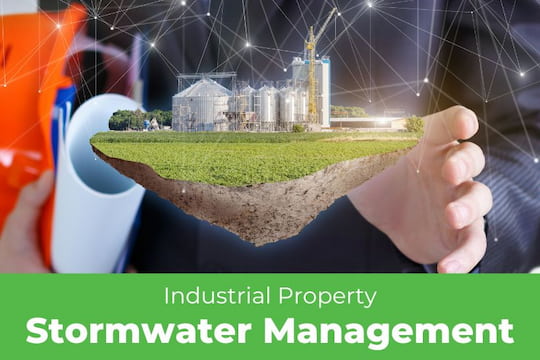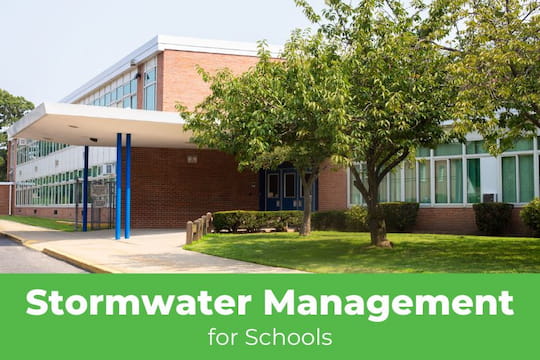When owners and property managers neglect stormwater management, it can lead to system failures that unleash a domino effect of destructive outcomes for commercial properties and the environment. The aftermath of neglect is costly, from flooding and collapsed culverts to cracked foundations and other problems. Poorly managed stormwater systems on commercial properties can endanger the public and threaten local ecosystems and water quality.
As storms become more extreme and frequent, detecting and addressing the vulnerabilities in stormwater systems is imperative for sustainable, cost-effective, and resilient stormwater management.
The consequences of a neglected system are multi-faceted and far-reaching. Commercial property managers and homeowners associations (HOAs) can expect financial implications in the following areas.
Costly Property Damage

When stormwater is uncontrolled or not controlled adequately through a properly designed and maintained system, the volume of water can cause significant damage. Flooding, eroded areas, and property damage can result. Damage to property from pooling water and erosion can include cracks or buckles in sidewalks and parking lots, damage to building foundations, and mold in buildings. Landscaping can suffer from topsoil erosion, and other property infrastructure can also become damaged from poorly controlled stormwater.
In some areas, the stormwater system is combined with the property's sewage system. When the system fails due to neglect, aside from property damage, the overflowing sewage can pose serious public health and environmental risks. Managing these types of damages can be expensive and may reoccur if the stormwater system is not repaired or upgraded to address the neglect and other factors contributing to failures.
Increased Maintenance Costs
When property managers and owners neglect stormwater system management, the properties will start experiencing stormwater drainage problems. Over time, debris, sediment, and other pollutants build up and clog existing catch basins and other devices to channel and manage the water flow. Getting the system on a regular maintenance schedule may require much work to clean up and compensate for issues that have escalated due to previous poor or absent maintenance.
Commercial properties' paved areas comprise part of their stormwater management system. The amount of stormwater needing management is related to the amount of impervious ground on the property. Larger parking lots and concrete spaces require more maintenance, such as street sweeping, trash removal, and frequent catch basin clean-outs. They also create more significant volumes of runoff that must be effectively managed so that it does not cause property damage and incur more costs.
Repairing and Replacing Infrastructure

Stormwater management systems consist of inlets, catch basins, drains, retention basins, culverts, and other devices to manage water flow. These devices deteriorate due to age and use if they do not receive proper, routine maintenance. Some commercial properties have culverts that serve as bridges, and poor maintenance can cause culverts to collapse. Clogs, rusted or corroded exposed metal components, cracked concrete, and other damage can go unnoticed without routine inspection and maintenance. A culvert failure can become hazardous to traveling public and cause traffic disruptions.
Storm drain cleaning, repairing cracked or broken pipes, clearing branches and garbage from various points in the stormwater system, and other routine maintenance tasks can keep stormwater system devices in good working order. Replacing or repairing these devices can become more costly if they are not regularly repaired and kept up.
Legal and Regulatory Issues
Neglecting stormwater management can lead to accidents on a property. Injuries due to flooded areas, slippery pavement, and other hazards can lead to individuals making liability claims and the properties incurring legal expenses to defend against those claims.
HOAs and other commercial properties are also typically subject to local stormwater management regulations. Neglected systems can result in water quality violations, non-compliance with codes or permits, and endangerment of already endangered species. Increased flooding from a neglected system can violate floodplain management regulations. Failing to address issues can attract attention from the Environmental Protection Agency (EPA), leading to enforcement and legal actions. Neglecting to heed these regulations may also add fines and penalties that cause financial strain for HOAs and property owners.
Violations for Erosion Control
Failing to implement proper erosion control methods can result in costly violations and financial penalties. If a property suffers from soil erosion during and after storms, soil loss can degrade the property. The eroded soil can also cause damage to neighboring properties and local waterways as it causes sediment to build up where it doesn’t belong. It can exacerbate other problems, such as water pollution, if the eroding soil also contains chemicals, litter, fertilizers, and nutrients that get deposited into local water bodies.
Increased Insurance Premiums
Property damage due to stormwater drainage problems and related issues can trigger insurance claims and cause insurers to raise policy rates. Frequent insurance claims to cover damage from a poorly maintained system can result in HOAs and commercial properties being placed into high-risk categories and receiving much higher insurance costs or even a canceled policy.
Problem Mitigation and Remediation
When stormwater-related problems are allowed to continue, the costs of mitigating the problems increase. Damages can accumulate over multiple storms or rainy seasons and require significant expense to address environmental damage. Remediating to prevent future issues means the stormwater management system may require advanced devices and upgrades, which can also be expensive.
Loss of Business Revenue

For office buildings, shopping centers, and other commercial properties, floods and other stormwater drainage problems caused by poor stormwater management can prevent businesses from operating as usual, which can cause them to lose revenue. Ongoing issues can deter tenants from renting and make the property less desirable, negatively impacting business income.
The property's aesthetics and functionality may suffer when stormwater is not effectively or adequately managed. Eroded plantings, flooded or washed-out garden areas, and trash and other debris collecting in the property’s storm drains can affect public perception and decrease property values, which can impact the financial health of the HOA or commercial property investment.
Start Saving Money Today
To keep properties and the community safe from the fallout of stormwater system neglect and to prevent unnecessary spending on repairs and damage cleanups, HOAs and commercial property managers must take proactive measures to handle stormwater. Prioritizing regular catch basin cleaning and other maintenance, upgrading old systems, and repairing compromised devices is essential.
Maintaining a stormwater system does not have to be difficult when you hire an outside specialist like CatchAll Environmental. Our professionals will inspect, repair, and maintain your stormwater system to minimize costs and maximize effectiveness. Our team can ensure your system remains in regulatory compliance, and our economical solutions make it easy for you to put stormwater system maintenance on auto-pilot. Contact CatchAll Environmental today to see how we can optimize your system to save money.













.jpg)


